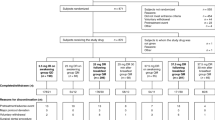Abstract
The purpose of this study was to determine compliance with dosing instructions, and the prevalence of possible adverse events, when risedronate is used in clinical practice. 219 patients were studied. We found that despite counseling one in four patients were non-compliant with dosing instructions. Those patients who did not stay upright after taking risedronate were more likely to have an adverse event and to discontinue the drug. Adverse events were experienced by 38% of patients, the commonest being gastrointestinal. Upper GI adverse events occurred in 21% of patients. A previous history of upper GI symptoms applied to 44% of patients and significantly more of them experienced upper GI adverse events than those with no history of GI problems. Forty two (19%) of patients taking risedronate stopped therapy due to adverse events, but only ten of these patients had contacted the Osteoporosis Unit about these symptoms. Approximately one third of the patients who experienced adverse events in this study had attempted a rechallenge with the drug. This was worthwhile, however, as in almost 50% of these patients their symptoms settled and they continued with therapy. This study has highlighted the importance of following up patients on long-term osteoporosis medication to ensure optimal compliance. The use of specialized osteoporosis nurses in clinics or primary care to follow up patients needs to be addressed.
Similar content being viewed by others
References
Reginster JY et al. (2000) Randomised trial of the effects of risedronate on vertebral fractures in women with established osteoporosis.Osteoporosis Int 11:83–91
Harris ST, Watts NB, Genant HK et al. (1999) Effects of risedronate treatment on vertebral and nonvertebral fractures in women with postmenopausal osteoporosis. JAMA 282:1344–1352
Cohen S, Levy RM, Keller M,et al. (1999) Risedronate therapy prevents corticosteroid-induced bone loss. Arthritis Rheum. 42:2309–2318
Reid DM, Hughes RA, Laan RFJM, et al., for the European Corticosteroid-Induced Osteoporosis Treatment Study (2000) Efficacy and safety of daily risedronate in the treatment of corticosteroid-induced osteoporosis in men and women: a randomized trial. J Bone Min Res. 15:1006–1013
Fogelman I et al. (2000) Gastrointestinal side effects and endoscopic findings similar between risedronate and placebo-treated patients.Osteoporosis Int 11(Suppl. 2):S179, 459
Ettinger B, Pressman A, Schein J et al. (1998) Alendronate use among 812 women: prevalence of gastro-intestinal complaints, non-compliance with patient instructions and discontinuation. Journal of Managed Care Pharmacy:488–492
Kelly R, Taggart H. (1997) Incidence of gastrointestinal side effects due to alendronate is high in clinical practice. BMJ 315:1235
De Groen PC, Lubbe DF, Hirsch LJ, et al. (1996) Esophagitis associated with the use of alendronate. N Engl J Med. 335:1016–1021
Taggart H, Bolognese MA, Lindsay R et al. (2002) Upper gastrointestinal tract safety of risedronate: a pooled analysis of 9 clinical trials. Mayo Clin. Proc. 77:262–270
Schnitzer T, H.G. Bone, G. Crepaldi et al. (2000) Therapeutic equivalence of alendronate 70 mg once-weekly and alendronate 10 mg daily in the treatment of osteoporosis. Aging Clin. Res. 12:1–12
McMurray JJV, Stewart S. (1998) Nurse led, multidisciplinary intervention in chronic heart failure (editorial). Heart 80:430–1
Author information
Authors and Affiliations
Corresponding author
Rights and permissions
About this article
Cite this article
Hamilton, B., McCoy, K. & Taggart, H. Tolerability and compliance with risedronate in clinical practice. Osteoporos Int 14, 259–262 (2003). https://doi.org/10.1007/s00198-002-1370-3
Received:
Accepted:
Published:
Issue Date:
DOI: https://doi.org/10.1007/s00198-002-1370-3




